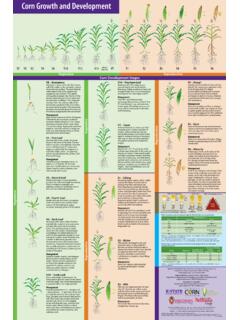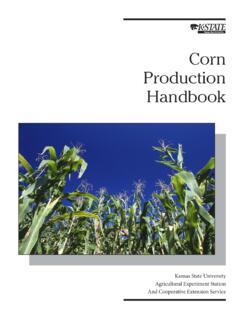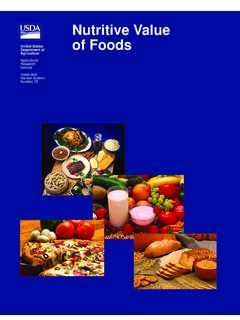Transcription of WHEAT STANDARDS 2021-2022 © Copyright GrainCorp Ltd
1 Varietal RestrictionsVarietal restrictions apply to the grades on this chart. A variety must not be binned above its maximum allowable varietal classifi cation (APH2 > H1/H2 > APW1 > ASW1 > AGP1 > FED1).Only APH2 and H1/H2 varieties may be binned in AUH2 & HPS1. H1 segregations are only off ered in the southern STANDARDS are to be applied on individual truck loads and must not be averaged over a number of indicated on this chart are only available where CodeBinned GradeAPH2H1H2 AUH2 APW1 ASW1 AGP1 HPS1 SFW1 FED1 MOGR Moisture Maximum (%) Protein Minimum (%) Limit No Limit No LimitTWTTest Weight Minimum (kg/hl)76767671767668687062 SCRNS creenings (All Material Below the Screen) Maximum (% by weight)Material passing through a slotted screen after 40 Material Above the Screen Maximum (% by weight)Material other than WHEAT kernels remaining on top of a slotted screen after 40 consists of whiteheads (with grains removed)
2 , chaff , backbone, Wild Radish pods, Millk Thistle pods, Skeleton Weed Flowers (Seed Heads), other seedpods and other light material which remains above the screen after a sample of grain is subjected to the screening process. It excludes contaminants for which tolerances have been stated in these Number Minimum (seconds)350300300250300300200250No Limit No LimitDefective Grains Maximum tolerance as per method specifi ed. Note: NIL tolerance applies to the entire defi nitions are to be read in conjunction with the photo in the Visual Recognition STANDARDS Guide which depicts the minimum standard for a grain to be classifi ed as Maximum (% by count per 300 grain Sample)The covering of the germ is split. It includes early and any further advanced stage of growth of the germ.
3 Kernels exhibiting early stages of sprouting are those where the covering of the germ is split, but without further development of the with pin holes are not included in this defi nition. Note: The NIL tolerance for sprouted grains does not apply if a Falling Number analysis is Limit No LimitSTANS tained Maximum (% by count per 300 grain Sample)A distinct dark brown to black discolouration on the germ end that, in severe cases, may progress to other parts of the grain such as the crease. Grains are commonly referred to as black point or black tip . Includes streaking and brush-end staining beyond the minimum and up to 50% of the entire grain surface. For staining level greater than 50%, refer to Field Fungi. Also includes adherence of contaminants such as soil, dust, plant parts and other (15 grains)5%(15 grains)5%(15 grains)15%(45 grains)5%(15 grains)5%(15 grains)15%(45 grains)10%(30 grains)15%(45 grains)50%(150 grains)PFUNPink Stained Maximum (% by count per 300 grain Sample)Grains with distinct pink discolouration.
4 Grains that are pink but also contain a white to light grey fungal like discolouration over more than approximately 50% of the seed coat surface are to be classifi ed as White grain Disorder / Head Scab .2%(6 grains)2%(6 grains)2%(6 grains)2%(6 grains)2%(6 grains)2%(6 grains)5%(15 grains)3%(9 grains)5%(15 grains)5%(15 grains)WGDHW hite grain Disorder/Head Scab Maximum (% by count per 300 grain Sample)Grains appear white to light grey but may also contain a pink discolouration. Discolouration must be over more than approximately 50% of the seed coat surface. If the discolouration is less than approximately 50% of the seed coat surface, grains may be classifi ed as sound. Grains may also appear fl aky with a white discolouration or resemble (3 grains)1%(3 grains)1%(3 grains)1%(3 grains)1%(3 grains)1%(3 grains)1%(3 grains)1%(3 grains)1%(3 grains)1%(3 grains)GREE Dry Green or Sappy Maximum (% by count per 300 grain Sample) 1%(3 grains)1%(3 grains)1%(3 grains)2%(6 grains)1%(3 grains)1%(3 grains)5%(15 grains)2%(6 grains)10%(30 grains)No LimitDISTD istorted Maximum (% by count per 300 grain Sample)Grains generally have the appearance of full sized kernels with little or no structure on both dorsal sides of the grain , and are typically grey to blue in colour.
5 Does not include pinched (3 grains)1%(3 grains)1%(3 grains)2%(6 grains)1%(3 grains)1%(3 grains)10%(30 grains)2%(6 grains)10%(30 grains)No LimitDAMII nsect Damaged Maximum (% by count per 300 grain Sample)1%(3 grains)1%(3 grains)1%(3 grains)1%(3 grains)1%(3 grains)1%(3 grains)2%(6 grains)2%(6 grains)2%(6 grains)4%(12 grains)ARTD Over-Dried Damaged Maximum (% by count per 300 grain Sample)NILNILNILNILNILNILNILNILNILNo LimitFFUNF ield Fungi Maximum (count per half litre)Individual kernels where more than half (50%) of the seed coat is discoloured. Discolouration can vary from dark grey, brown to black in colour. Grains that are approximately 50% or less discoloured are to be classifi ed as Stained. Does not include Severely Damaged (count per half litre above screen)Mould, heat damaged/burnt, or other serious visual defects.
6 Grains that have become severely discoloured. Grains appear reddish brown, dark brown,or in severe cases, blackened. Does not include Field Fungi. 1111 1 1 1 1 1 5 SMUTAll Smuts (except Loose Smut) Maximum (entire load)Includes: Ball Smut, Stinking Smut, Bunt, Covered Seed Contaminants Tolerances apply to whole seeds or their equivalent in pieces and refer to the maximum total of all seeds named in each type per half litre. Except Type (1) in which the maximum applies on an individual seed basis per half (1): Colocynth, Double Gees/Spiny Emex/Three Cornered Jack, Jute, Long Head Poppy, Mexican Poppy, Opium Poppy, Field Poppy, Horned Poppy, Wild Poppy, New Zealand Spinach, Parthenium Weed** (QLD only)8*8*8*8*8*8*8*8*8*8*WS2 TYPE(2): Castor Oil Plant, Coriander, Crow Garlic/ Wild Garlic, Darling Pea, Parthenium Weed** (NSW/VIC/SA), Peanut seeds and pods, Ragweed, Rattlepods, Starburr, St.
7 John s WortNILNILNILNILNILNILNILNILNILNILWS3 ATYPE(3a): Bathurst Burr, Bellvine, Branched Broomrape, Bulls Head/Caltrop/Cats Head, Cape Tulip, Cottonseed, Dodder, Noogoora Burr, Thornapple2222 2 2 2 2 2 2WS3B TYPE(3b): Vetch (Tare), Vetch (Commercial)4444 4 4 4 4 4 4WS3C TYPE(3c): Heliotrope (Blue), Heliotrope (Common) **Note: included in this Type are tolerances for seeds or Pods /8 Seeds2 Pods /8 Seeds2 Pods /8 Seeds2 Pods /8 Seeds2 Pods /8 Seeds2 Pods /8 Seeds2 Pods /8 Seeds2 Pods /8 Seeds2 Pods /8 Seeds2 Pods /8 SeedsWS4 TYPE(4): Bindweed (Field), Cutleaf Mignonette, Darnel (Drake Seed), Hexham Scent/King Island Melilot** (only acceptable if no tainting odour is present), Hoary Cress, Mintweed, Nightshades, Paddy Melon, Skeleton Weed, Variegated Thistle20202020202020202020WS5 TYPE(5): Knapweed (Creeping/Russian), Sesbania Pea, Patterson s Curse/ Salvation Jane40404040404040404040WS6 TYPE(6): Colombus Grass, Johnson Grass, Saff ron Thistle10101050101050505050WS7 ATYPE(7a): Adzuki Beans, Broad Beans, Chickpeas, Corn (Maize), Cowpea, Faba Beans, Lentils, Lupins, Medic Pods, Peas (Field), Saffl ower, Soybean, Sunfl ower and any other seeds or pods greater than 5mm in diameter.
8 Includes Onion Weed Pods regardless of (7b): Barley (2 & 6 row), Bindweed (Australian), Bindweed (Black), Brome Grass, Carrot Weed, Durum (unlimited in FED1), Red/Spring Feed Wheats (unlimited in FED1), Oats (Black/Wild)*, Oats (Sand), Oats (Common), Rice, Rye (Cereal), Ryegrass on Stalk, Sorghum ( grain ), Triticale, Turnip Weed Pod and any other foreign seed not specifi ed in Types 1-7(a), Unmillable Material above the screen or in Foreign Seeds maximum (% by weight)Foreign seeds not already specifi ed in Types 1-7(b) that fall below the screen during the screenings *Individual Seed Basis ** Parthenium Weed is a NIL tolerance in NSW/VIC/SA **Hexham Scent is only acceptable if no tainting odour is present ** Heliotrope pods must be opened and the seeds counted Other Contaminants - Maximum tolerance as per method specifi ed.
9 Note: NIL tolerance applies to the entire Compounds Maximum (entire load)NILNILNILNILNILNILNILNILNILNILCHEM Chemicals Not Approved for WHEAT Maximum (entire load)NILNILNILNILNILNILNILNILNILNILERGR Ryegrass Ergot Maximum (length in cm when pieces are aligned per half litre)2cm2cm2cm2cm2cm2cm2cm2cm2cm2cmERGW Cereal Ergot Maximum (count per half litre)1111 1 1 1 1 1 1 LIVES tored grain Insects and Pea Weevils: Live maximum (entire load)NILNILNILNILNILNILNILNILNILNILINLGF ield Insects Large, dead or alive Maximum (count per half litre)Includes: Desiantha Weevil, Pea Weevil (dead only), Sitona Weevil, Rutherglen bugs, ladybirds, grasshoppers and wood bugs, whole or parts thereof. These are insect contaminants of grain that do not cause damage to stored 3 3 3 3 3 3 INSMF ield Insects Small, dead or alive Maximum (count per half litre)Includes: all species of aphid, minute mould beetle, mites & stored grain insects (dead only).
10 These are insect contaminants of grain that do not cause damage to stored Snails (Live or Dead) Maximum (count per half litre)1111 1 11051010 EARE arcockle Maximum (count per half litre)10101010101015101550 LSMT Loose Smut Maximum (count per half litre)3333 3 3 3 3 3 3 SAND Sand Maximum (count per half litre)20202050202050505050 EART Earth Maximum (count per half litre) Defi ned as a clod of dirt, being 5mm or less in 1 1 3 1 3 6 STON Stones (g per above screen) Maximum weight of all Stones retained above a screen per 4 4 4 4 4 4 OBJMO bjectionable Material Maximum (entire load)Presence of meat meal, blood meal, fi sh meal, poultry off al meal or other animal proteins. Sticks/Stubble (>3cm in length and/or 1cm in diameter), glass, concrete, metal, fertiliser, animal excreta, animal carcasses, tainting agents or any other commercially unacceptable contaminant, odour or taste greater than the tolerance or specifi cations as allowed in these Foreign Material Maximum (% by weight) Includes fi ne material (dust and minerals), pieces of snail shell (<half), pieces of stored grain insects, other non-vegetative material not STANDARDS 2021-2022 THIS CHART IS INTENDED TO ACT AS A GUIDE ONLY Copyright GrainCorp Ltd GrainCorp Enquiries Toll Free 1800 809 482 on 01 August 2021



